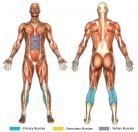Standing Calf Raises (Machine)
- Adjust the shoulder pads so that the knees must be bent in order to position oneself underneath the pads (about six inches of leeway is desired). Once in position underneath the pads, place the balls of the feet on the feet plate with the heels hanging down over the edge.
- Inhale, press with the feet (plantar flexion) until the calves are fully flexed, keep the legs straight at the knees and the abdominals tensed, and exhale throughout the (positive) motion.
- Lower until the heels are lower than the feet plate, (a deep stretch will be felt in the calves), and inhale throughout the (negative) motion.
- Repeat steps 2-3.
If building calf mass is the goal, then lifting with heavy weights is almost unequivocally required. The calves are usually considered to be the most arduous muscle of the body to develop because they are accustomed to being worked constantly by the mere act of ambulating from place to place. The calves are capable of a notably high quantity of work. Getting results in calf strength, definition, or mass will, for most, require mental fortitude and strong, unwavering volition.
Likewise, if building calf endurance is the goal, then lifting with high repetitions is almost absolutely required. The same reason as above applies.
In theory, the feet can be positioned in different ways to change the focus of stress on the calf muscles. By pointing the feet outwards it is possible to isolate the inner calf (medial gastrocnemius) and, conversely, by pointing the feet inwards it is possible to isolate the outer calf (lateral gastrocnemius). For most, it will take practice to achieve this result, even with proper foot placement. Separating the stress put on the gastrocnemius from the soleus is much easier to accomplish. (e.g., Standing calf raises will work the gastrocnemius more, while seated calf raises will work the soleus more).
The weight should be such that you can raise up fully onto the balls of your feet for the majority of the repetitions. Once your calves are exhausted, finish you set by executing partial repetitions. The muscular burn you experience will likely be intense, but if you want results it the price that must be paid.
Performing calf raises with a large amount of weight pressing down on one's shoulders can lead to spinal compression. Caution should be taken while performing this exercise.
Additionally, as with any heavy weight placed on the shoulders, an imprint from the device used may result from use whether it is a barbell or machine pad. While generally harmless, these imprints, depending on the severity, can last as long as three days.





